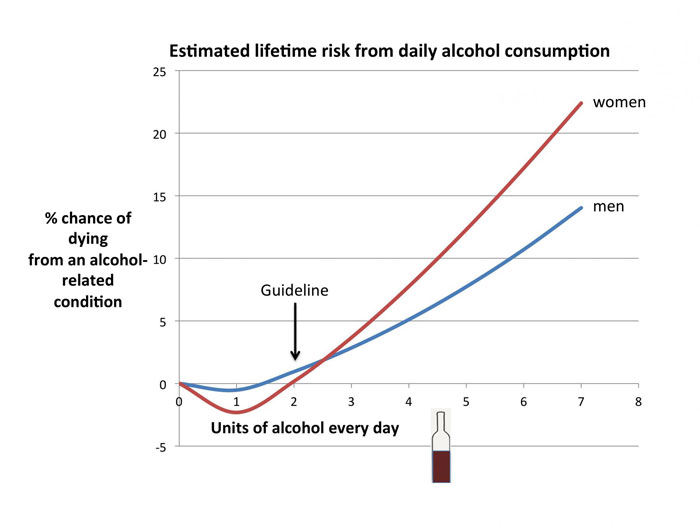The Chief Medical Officer announced new guidelines for alcohol consumption [earlier this year]. The Summary says,
The proposed guidelines and the expert group report that underpins them, have been developed on the basis of the following principles:
- People have a right to accurate information and clear advice about alcohol and its health risks.
- There is a responsibility on Government to ensure this information is provided for citizens in an open way, so they can make informed choices.
This admirable aim of treating the public as adults capable of making up their own minds seems in stark contrast with the authoritarian tone of publicity from the Department of Health, which baldly says “Men should not drink more than 14 units of alcohol each week, the same as women”.
Neither the press release nor the Summary of the guidelines provide any information on the effects of higher consumption, but Tables 10 and 11 of the full expert reportprovides the estimates plotted below.
 Estimated lifetime risk from regular daily consumption of alcohol, as given in Expert Report: the half-bottle indicates roughly what 4.5 units means. The 'Guideline' is for 14 units over a week rather than 2 units a day, and the curves are slightly different if the 14 units are not evenly spread over the week
Estimated lifetime risk from regular daily consumption of alcohol, as given in Expert Report: the half-bottle indicates roughly what 4.5 units means. The 'Guideline' is for 14 units over a week rather than 2 units a day, and the curves are slightly different if the 14 units are not evenly spread over the week
This, I feel, really does provide important information:
- At one unit a day (half a standard glass of wine), they estimate a tiny overall benefit for men and a slightly larger, but still small, overall benefit for women. But the Department of Health appears very eager to avoid the message of “a small glass of something for medicinal purposes”.
- However, after the first ‘medicinal’ unit, each subsequent one steadily raises the risk.
- The ‘low-risk’ threshold is at a very low level, where the small benefit in heart disease and stroke has been overwhelmed by cancer and other harms.
- There is a dramatically increased risk for higher consumption, with women having a steeper gradient than men.
A simple summary of these curves might be that units are medicine, poison, poison, poison,..... . As two units is a standard glass of wine, which seems to leave you roughly quits, maybe best only to have a mouthful. If you can stick to that.
Popular response to the announcement seems to have been, predictably, extremely varied. Although only 24% of men and 18% of women report drinking regularly more than the guidelines, many were vocal in the condemnation of the ‘nanny-state’. Perhaps if they had been given clear information as to the potential consequences of their habit, they might not so easily have been so dismissive, although it's limited what can be put over in a few soundbites.
Changing individual behaviour and the surrounding culture is an immensely complex and subtle issue. But I think there is an irreconcilable tension between providing information with the aim of enabling people to make an informed choice, and telling people what they should do. Rather than trying to do both in a single announcement, perhaps future public health communications should clearly separate these two processes.
Explaining a 1% lifetime risk
I got a surprising amount of coverage due entirely to submitting a quote to the Science Media Centre.
“These guidelines define ‘low-risk’ drinking as giving you less than a 1% chance of dying from an alcohol-related condition. So should we feel OK about risks of this level? An hour of TV watching a day, or a bacon sandwich a couple of times a week, is more dangerous to your long-term health. In contrast, an average driver faces much less than this lifetime risk from a car accident. It all seems to come down to what pleasure you get from moderate drinking.”
My comparators were chosen as daily activities that could be linked to all-cause mortality 'hazard ratios' of around 1.05, that is a 5% increased risk of dying each year. I used two measures:
- One hour's TV a day: a large and reputable recent UK study found that 2 hours TV watching each day was independently associated with a hazard-ratio of 1.09 – I scaled this down to 1 hour giving a hazard ratio of around 1.05
- A couple of bacon sandwiches a week: another study from EPIC estimated a hazard ratio of 1.19 from daily consumption of 50g of processed meat a day: a couple of bacon sandwiches a week is around 15g a day, so might be associated with a hazard ratio of around 1.05.
These hazard ratios cannot be directly compared with the metric of “lifetime risk”. But Figures 12 and 13 in the Expert Report give hazard ratios associated with alcohol consumption for different age-groups, and it is clear that for the guideline consumption the hazard ratios for older age-groups (where the main impact will occur) are well under 1.05. I openly acknowledge some fairly heroic interpolation of risk to low exposures of TV watching and bacon sandwiches, but I feel that these are reasonable indicators of the potential harms of sedentary behaviour and harmful diet.
For driving, I used the current GB estimate of 2 car-occupant deaths per billion miles – this means that a a 1% chance of death would require around 5,000,000 miles, or 100,000 miles a year over 50 years, a vast quantity of driving. Alternatively, we can simply observe that around 1 in 300 deaths is on the roads, as 1700 people were killed in Great Britain last year out of around 550,000 deaths. So transport accidents now give a lifetime risk of well under 1 in 100.
The main point I wanted to make was that people should be provided with information so they can make an informed choice. But maybe 'medicine, poison, poison, poison, poison..." is all people need to know.
This article was originally published at Understanding Uncertainty under a CC-BY-NC-SA licence


Rate and Review
Rate this article
Review this article
Log into OpenLearn to leave reviews and join in the conversation.
Article reviews